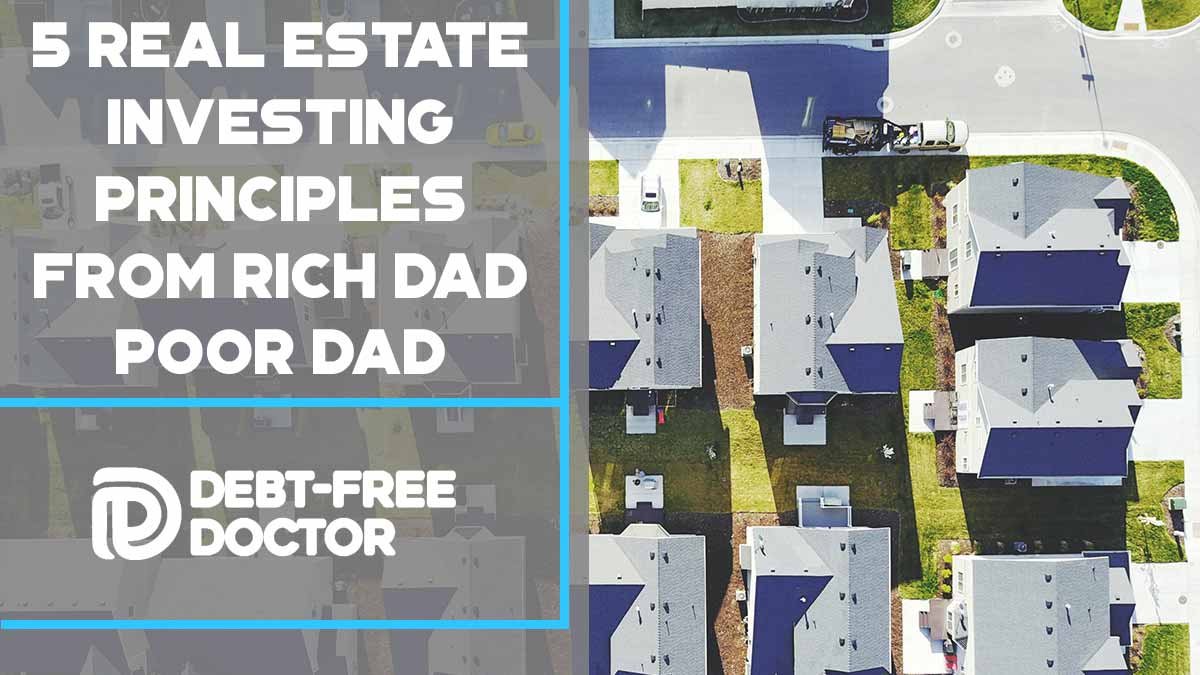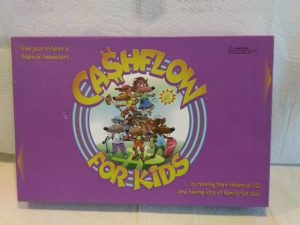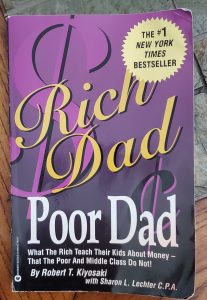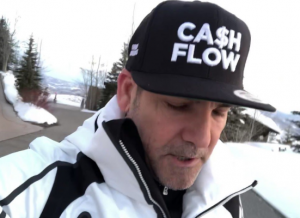

This summer, while bass fishing, my friend informed me that he’s started focusing on real estate, specifically fix and flips.
What’s amazing is that even at 23 years old, he already understood the concept of “getting your money to work for you.”
He wanted to know a few resources to begin learning more about real estate. I recommended possibly the top personal finance book of all time that I read when first starting my journey, Robert Kiyosaki’s Rich Dad Poor Dad.
If you ask most real estate investors about the first book that motivated them to pursue passive income via real estate, it would be Kiyosaki’s book.
The first lesson in the book says it all: The poor work for money, and the rich make their money work for them.
Even though the book is most popular among real estate investors, it does NOT teach you “HOW” to invest. Instead, it focuses on “WHY” you focus on assets that pay you regardless if you’re working or not.
“Often, the more money you make, the more money you spend; that’s why more money doesn’t make you rich – assets make you rich.” – Robert Kiyosaki
Real estate investing starts with a mindset shift; his book does a great job of this.
Don’t Miss Any Updates. Each week I’ll send you advice on how to reach financial independence with passive income from real estate.
When you think about creating a real estate investment strategy, one thing seems to be constant: You must first start off reading Rich Dad Poor Dad.
Robert Kiyosaki is best known as a teacher and author of the Rich Dad Series: Here are some of the R ich Dad books:He also created a popular board game that teaches people about money called The Cashflow Board Game and even one for kids too.

Like many successful people, early on in his career, he had a series of setbacks only to build himself back up to reach financial freedom.
He served in the Marine Corps before starting a company that launched the Velcro Surfer Wallet ( I had one of those!) and rock band t-shirts – both of which failed.
He began to repay his debts buy learning how to invest in stocks and real estate.
He eventually went on to become an author and teacher, using his previous experiences to educate people on what to avoid along the way to building a multimillion-dollar training brand.
Where did you learn about money?
In school? Me neither.
As a doctor, it’s hard to believe how a “system” can put us through 20+ years of education to get a job and ultimately to make money yet NEVER teach us how to handle money.
Maybe this is why the U.S. student loan debt totals $1.71 trillion and grows 6x faster than the nation’s economy.
Here are a few other stats from educationdata.org:
Because we don’t receive financial education in school, most of us get it from our parents. Maybe this is the reason that the statement “the rich get richer and the poor get poorer” is true.
In his book, Kiyosaki also heard about the rich getting richer and the poor losing money growing up and wanted to share his story about what he learned about wealth.

Interestingly, he learned it from two people: his “rich dad,” who was actually one of his friend’s dads, and his “poor dad,” who was his real one.
His biological father (poor dad) was an educated college professor that who recommended him to go to school, get a job, and work hard the rest of his life.
On the other hand, Kiyosaki’s “rich dad” was one of the wealthiest business owners in Hawaii who never finished high school.
During his childhood years, he began getting different messages about money from both fathers.
Kiyosaki stated, “I noticed that my poor dad was poor, not because of the amount of money he earned, which was significant, but because of his thoughts and actions.“
Although his “rich dad” was a high school dropout, he eventually became a millionaire by putting the power of money to work for him.
And the rest is history…
“It is what you know that is your greatest wealth. It is what you do not know that is your greatest risk. There is always risk, so learn to manage risk instead of avoid it.” – Robert Kiyosaki
It’s a fact that most people who want to improve in life focus on making more money. Remember our previous discussion regarding the lack of financial education growing up?
What do most people do whenever they earn more? Spend more, right? I understand this isn’t always the case, but for the most part, the more we make, the more that leaves our pocket.
It doesn’t matter what comes in if all of it continues to go out. According to Kiyosaki, one key difference between the rich and the poor is that the rich focus on keeping their money to make it work harder for them.
He states, “You must know the difference between an asset and a liability and buy assets. If you want to be rich, this is all you need to know. It is rule number one. It is the only rule.”
As a father of two teenagers, I’ve made it a point to begin teaching them how to handle money, and they understand that Assets put money in our pockets and liabilities take money out.
Kiyosaki recommends that we focus on investing in assets that produce income (cash flow) and appreciation, such as real estate.
If you currently have a job trading time for money, then:
“If you work for money, you give the power to your employer. But if money works for you, you keep the power and control it.” – Robert Kiyosaki
In the book, Kiyosaki states that he learned to put his money to work for him and enjoy tax benefits of generating income that does NOT come from a paycheck.
His poor dad would say, “I can’t invest; I have no money.” Meanwhile, his rich dad would look for opportunities to invest time to start a business to make money or find additional sources of income.
My wife and I took Kiyosaki’s advice and started investing in cash-flowing investments, such as real estate syndications.
Want to learn more about my favorite investment, real estate syndications? Check out this video:
We’ve now been able to take more time off as other income streams are being created.
Mcdonald’s is a MASSIVE real estate empire.

Founder Ray Kroc didn’t realize this early on until he hired someone to review his books and find out why his business was losing money.
He was told, “Mr. Kroc, you’re NOT in the burger business. You’re in the REAL ESTATE business. You build an empire on the land upon which that BURGER is cooked.“
After hearing this, he understood that each franchise’s land and location were the most significant factors of his success.
“The long-term rich build their asset column first,” Kiyosaki writes. “Then the income generated from the asset column buys their luxuries. The poor and middle class buy luxuries with their own sweat, blood, and children’s inheritance.”
Rich people understand the tax system and search for opportunities to make the tax laws work for them.
They understand how setting up corporations can lower their overall tax rate vs the individual (employee) that works for a corporation.
One of the main differences is how business owners and investors with corporations such as C Corps, S Corps, or LLCs pay taxes to how most people pay tax:
Business owners with a corporate structure:
Employees who work for corporations:
Notice that employees spend their money post-tax and pay MORE in taxes, while business owners earn and spend before paying tax.
This is based on employees not being able to expense items they purchase.
“If you work for money, you give the power to your employer. If money works for you, you keep the power and control it.”

“Don’t be addicted to money. Work to learn. Don’t work for money. Work for knowledge.”
Throughout the book, Kiyosaki stresses the importance of acquiring knowledge over money.
He states:
“I recommend to young people to seek work for what they will learn, more than what they will earn. Look down the road at what skills they want to acquire before choosing a specific profession and before getting trapped in the Rat Race.”
Poor Dad was intelligent and well-educated and worked for money because job security meant everything to him. Rich Dad became a millionaire by working to learn.
I see too many professionals who STOP the learning process after their training is completed. Many feel that they’ve had enough education and don’t feel the need to have to learn anything new.
This is a mistake.
Once I became interested in learning about real estate, I had to learn many new skills and a whole set of terminology such as:

The book states, “The primary difference between a rich person and a poor person is how they manage fear.”
This “fear” he’s talking about is the fear of losing money.
For most people, the reason they don’t win financially is because the pain of losing money is far greater than the joy of being rich.
Most successful people I know get to where they are in life because of the mistakes and failures they’ve made along the way.
Failure is part of the process. I should know, as I lost $50,000 on one of my first deals via crowdfunding (which I now know to avoid!).
If you become a real estate investor, know this. You WILL fail.
But you can turn failure into learning and inspiration, and ultimately success.
If I never played the game due to fear of losing/failing, then I’d NEVER get better.
Now that you’re familiar with the key Rich Dad Poor Dad lesson, there are 5 main principles that you can apply to grow your wealth through real estate investments.
The American dream is to get a good job and buy a home. Why rent when you can buy, right? The house you purchase to live in will eventually appreciate in value, making buying the right choice, right?
He says that having a mortgage payment is actually a liability and NOT an asset. Instead, we should focus on investing in assets that put money in our pockets in order to grow our wealth.

“One door is not an investment. One door is a liability.” – Grant Cardone
Other real estate gurus, such as Grant Cardone, also agree that buying a house is a mistake.
Cardone states that you shouldn’t own a home unless you have 20 million bucks in the bank. (I guess I should sell our home 🙂 )
He goes on to say that a home is not an investment because it doesn’t pay you every month. In fact, you have to pay it every month, which is why it’s a liability.
Nothing is a good deal if you have to feed it constantly.
Cardone gives out 3 main tips to aspiring entrepreneurs:
#1 Invest in yourself
#2 Focus on income
#3 Invest in something that pays YOU

There’s a story in the book about a gold miner in Peru who once told Kiyosaki, “There’s gold everywhere. Most people are not trained to see it.
Kiyosaki said that this was also true regarding real estate.He said he could find about four to five excellent properties a day, whereas others may look and find none.
We have to remember that not all properties are created equal. Some look bad and tattered on the surface, but with some TLC, they can easily bring thousands back in profit.
The real estate investors who win are the ones who can look beyond the surface to find the “gold.”After my training, I made it a habit to read on a daily basis about investing. Too many people think once they graduate their learning is finished. This is the WRONG way to approach life.
Readers are leaders.Once I began reading and learning about real estate, it sparked a newfound excitement in me. This particular area of investing was BRAND NEW to me, and I felt like a freshman in high school again.
It didn’t take long to get the basics of real estate down, but there’s so much more to learn.Speaking of learning, we all acquire knowledge differently. My top way to absorb new ideas is by reading. For you, it may be listening to podcasts or attending conferences.
Always look for ways to continue growing your knowledge base in order to scale your property business.
Proverbs 27:17 states, “As iron sharpens iron, so one person sharpens another.”Never underestimate the power of association. Choose who you hang out with wisely and surround yourself with others who are interested in real estate investing. This way, everyone can learn from each other’s habits and support each other.
I started off investing in real estate via crowdfunding with small debt deals. After a handful of these, I decided to step it up and invest in an equity deal in Oklahoma with a minimum investment of $50K.
Unfortunately, all investors in that deal lost their investment, which turned me off real estate for almost a year.
If I hadn’t kept learning from my mistakes during that downtime, I would have become extremely risk-averse.
Kiyosaki teaches investors to not let doubt cause you NOT to act.
Perform due diligence, and instead of criticizing a deal, analyze it. Don’t overcome your own doubts, or they will rule you forever.
As I’ve learned over the years, every dollar that I invest in real estate goes to work for me, and in more ways than one.
It’s like having a bunch of little soldiers out there doing the work for me.There are five core ways each dollar works for you when you invest it in real estate:
You can grow and scale a profitable business by leveraging your money to acquire assets that generate additional income.
In “Rich Dad Poor Dad,” author Robert T. Kiyosaki emphasizes the power of passive income through real estate investments. He shares insights from his “rich dad,” highlighting the importance of financial literacy and how rental properties can generate monthly income. Kiyosaki believes that understanding property investment is a starting point for financial success.
Kiyosaki often speaks about the significance of having a good property manager to handle rental properties efficiently. By ensuring properties are well-maintained and tenants are satisfied, a property manager can optimize rental income. Additionally, understanding property taxes and interest rates can further enhance the profitability of rental property.
The Rich Dad brand, including the teachings of both Robert and Kim Kiyosaki, emphasizes the importance of using other people’s money (like loans from financial institutions) for investments rather than relying solely on your own money. They also discuss the concept of capital gain and the importance of finding a great investment property. Methods like the BRRRR method and working with turnkey providers are also touched upon as strategies for success.
Yes, the Rich Dad Company, under the Rich Dad brand name, frequently releases new content, including books, social media posts, and articles in publications like the Wall Street Journal. These often reflect updated views on interest rates, market trends, and new strategies for property investment. Robert Kiyosaki, as a motivational speaker, also shares fresh insights in his talks.
One of the main reasons many are drawn to the “Rich Dad” approach is its emphasis on achieving financial freedom. By understanding the principles of financial literacy and leveraging the power of passive income from rental properties, individuals can work towards a future where they have enough money to live comfortably without being tied to a traditional job.